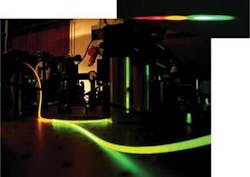ULTRAFAST PHYSICS: Somewhere over the event horizon, pump-probes shine
Black holes may be the bane of science-fiction space heroes, but University of St. Andrews (Scotland) physicist Ulf Leonhardt’s descriptions of them can remind one of a movie about a tornado in Kansas that sent a farm girl on a dream quest to the Land of Oz, only to wake up with a new appreciation for her rural home.
The same quantum catastrophes and event horizons that render black holes supernaturally awesome can also be observed, he says, in relatively mundane terrestrial phenomena that include rainbows, rivers flowing over waterfalls, and supersonic nozzles on rocket engines.
Far from mundane, however, was the laboratory simulation of a black-hole event horizon using a simple pump-probe experiment launched into an optical fiber, which was published in March by Leonhardt, König, and colleagues at St. Andrews.1 Friedrich König will speak about their project at CLEO (May 4-9, San Jose, CA).
For a number of years, Leonhardt’s group and several other research teams have been developing both optical and nonoptical methods for simulating black holes in the laboratory and investigating the radiation they are thought to emit, as theorized by and named after physicist Stephen Hawking at Cambridge University (England). A number of these methods require the supercooled environment of a Bose-Einstein condensate (see www.laserfocusworld.com/articles/65979).
Three and a half years ago, however, Leonhardt realized that event horizons also occur in light pulses propagating along optical fibers. “All you need to do is send pulses in a fiber,” he said. “The pulses change the refractive index and cause the phase velocity of the light to fall below the speed of the pulses. So for such light, the pulses would move with superluminal velocity, faster than the phase velocity of light.”
The effect is usually very weak, however. Even with pulses as short as 50 to 70 fs in duration, the effective change in velocity is only about 10-6, he said. “If you use ordinary telecommunications pulses, it’s even less, because the pulses are longer and not as intense,” he said. “So the Hawking radiation is astronomically small. We are trying to make these effects stronger, to make very short pulses with very sharp edges and to observe this effect, which actually occurs all of the time, whenever you send a pulse through fiber optics.”
To obtain their recently published results, the researchers launched an 800 nm pump pulse from a shared 70 fs laser system at St. Andrews into a commercially available microstructured optical fiber, followed by an infrared (1500 nm) probe from an off-the-shelf laser. This enabled them to observe the classical effects or frequency changes at the event horizon as a first step. For the second stage, focused on actually investigating quantum effects such as Hawking radiation, the researchers have bought a 7 fs probe laser, whose beam is launched following the pump into a microstructured optical fiber with a very narrow core, on the order of one square micron (see figure).
“Other people have done this, but we have achieved a very good coupling efficiency,” Leonhardt said. “We can launch extremely short solitons into the fiber that change radically as they propagate. They develop shock and experience significant Raman shifting.” The research program for Leonhardt’s team for the next year or so is on monitoring the rapid dynamics of such pulses and learning to optimize the shape of the pulses (very short with very sharp edges) to produce maximal Hawking radiation.
Unruh’s River
For a black-hole event horizon, the force that generates Hawking radiation particles is called a tidal force and is generated by gradients in the gravitational potential, he said. “In our case, the equivalent of gravitation potential changes comes from the optical intensity profile. So we need steep changes in potential to get a tidal force for photons, and that’s what we have to optimize.”
Leonhardt describes rainbows as diffraction catastrophes in which “the wave nature of light resolves ray singularities and draws delicate interference patterns.” In doing so he correlates them to quantum catastrophes such as black holes in which the quantum nature of light resolves wave singularities and creates characteristic quantum effects related to Hawking radiation. He also speaks of Unruh’s River, a concept named for physicist William Unruh at the University of British Columbia (Canada), in which the space-time geometry of a black hole is described using the metaphor of a river flowing toward a waterfall.
The water waves encounter an event horizon, or a point of no return, at the point where the river moves faster than the speed of the waves, and the waves can no longer propagate upstream. Fish swimming in the river would also encounter an event horizon at the point where the river begins to flow downstream faster than the fish can swim upstream. The point of no return in the exhaust nozzle on a rocket engine occurs when a narrowing of the lumen causes the rate of gas flow to go supersonic.
Only half in jest, Leonhardt used a similar analogy to describe his research. “In some ways, as a researcher on this you are also on the other side of the horizon. If you decide to embark on this project, you get addicted, and you can’t stop,” he said. “Psychologically speaking, I am on the other side of the horizon and this has been quite an adventure, which is not yet over. Now the only way is the way forward and to get this done.”
REFERENCE
1. T.G. Philbin et al. Science in press
About the Author
Hassaun A. Jones-Bey
Senior Editor and Freelance Writer
Hassaun A. Jones-Bey was a senior editor and then freelance writer for Laser Focus World.
